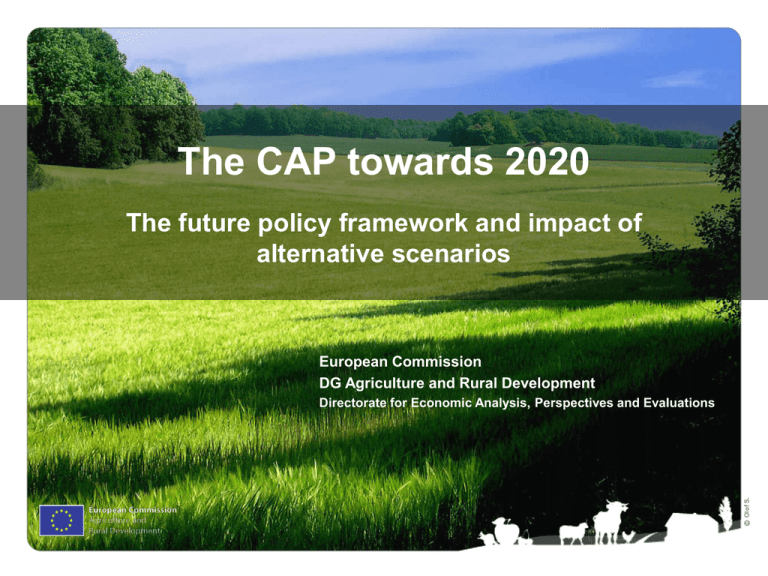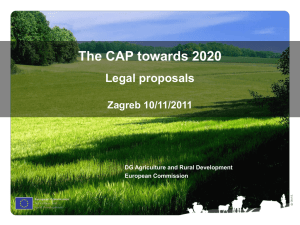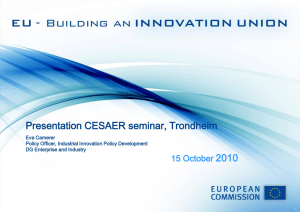The CAP towards 2020
advertisement

The CAP towards 2020 The future policy framework and impact of alternative scenarios European Commission DG Agriculture and Rural Development Ⓒ Olof S. Directorate for Economic Analysis, Perspectives and Evaluations Where are we with the CAP reform process? 12 April – 11 June 2010 19-20 July 2010 18 November 2010 23 November 2010 – 25 January 2011 29 June 2011 12 October 2011 Public debate (EU citizens and organisations) Public conference Commission Communication ‘The CAP towards 2020’ Consultation on Impact assessment (stakeholders) Commission proposals on the EU budget 2014-2020 Commission legal proposals on the CAP The legal proposals are accompanied by an impact assessment that evaluates alternative scenarios for the evolution of the policy on the basis of extensive quantitative and qualitative analysis Debate in the European Parliament and the Council 2011-2013 Approval of Regulations and implementing acts 2 Outline Part I: The future policy framework Part II: Impact assessment of alternative redistribution scenarios - Direct Payments - Rural Development 3 Part I: The future policy framework 4 The path of CAP expenditure 1980-2020 (in current prices) 70 EU-10 EU-12 EU-15 EU-25 EU-27 60 40 30 20 10 Export subsidies Other market measures Coupled direct payments Market-related expenditure Direct payments Rural development 2020 2019 2018 2017 2016 2015 2014 2013 2012 2011 2010 2009 2008 2007 2006 2005 2004 2003 2002 2001 2000 1999 1998 1997 1996 1995 1994 1993 1992 1991 1990 1989 1988 1987 1986 1985 1984 1983 1982 1981 0 1980 in billion € - current prices 50 Decoupled direct payments Source: DG Agriculture and Rural Development Notes: 2011 = Budget; 2012 = Draft Budget; 2013 = EAGF subceiling for direct payments and market-related expenditure + pillar 2 in commitments. Rural development for 2013 includes UK voluntary modulation and Article 136 “unspent amounts”. As these cease to exist end 5 2013, the corresponding amounts are put back to direct aids as from 2014. Challenges and CAP reform objectives Commission Communication ‘The CAP towards 2020’ Challenges Policy objectives Legal proposals Reform objectives Europe 2020 Economic Environmental Territorial Viable food production Sustainable management of natural resources and climate action Balanced territorial development Enhanced competitiveness Improved sustainability Greater effectiveness Simplification 6 New design of direct payments Degressivity and Capping (all layers except Green Payment) Cross compliance • Streamlined – Climate change Coupled support • Wide range of sectors • Up to 5% or 10% of DP envelope, to be decided by MS Natural constraint support • For areas with natural constraints • Up to 5% of the DP envelope Small Farmer Scheme • Simplification of claims and controls Young Farmer Scheme • Up to 2% of DP envelope • < 40 years • For 5 years • Commencing activity • Lump sum payment to be determined by MS under conditions ‘Green’ Payment • Crop diversification • Permanent grassland • Ecological focus area • Entrance in 2014 • 30% of the DP envelope • Up to 10% of the DP envelope Basic Payment Scheme • National or regional flat rate per eligible hectare • Regions and criteria to be chosen by MS • New entitlements in 2014 • Definition of agricultural activity • Definition of active farmer OR 7 Improved instruments to address market developments (sCMO) Forum for a Better Functioning Food Supply Chain Increased financing for research and innovation Sustainable consumption - School Fruit and Milk Scheme • Increased funding • New measures available for EU co-funding Encouraging common action – better position in the food supply chain • Facilitated recognition of: Producer Organisations (PO), Associations of POs, Interbranch Organisations • More clarity as regards competition rules • Link to Rural Development funds (start-up and co-operation measures) Link to the consumer Common responses to economic and environmental challenges Continued market orientation • End of certain aid schemes (Skimmed Milk Powder, hops and silkworms) • End of production limits (sugar) Enhanced safety-net • Exceptional measures – more flexibility and greater coherence • Public intervention/private storage simplified, more responsive to crises • “Crises reserve” Competitiveness of individual agricultural producers 8 Rural development in a new framework Europe 2020 strategy Common Strategic Framework (CSF) – covering the EAFRD, ERDF, ESF, Cohesion Fund and EMFF, and reflecting EU2020 through common thematic objectives to be addressed by key actions for each of the funds Partnership Contract – national document outlining the intended use of the funds in the pursuit of EU2020 objectives Rural development policy: EAFRD Other CSF funds (ERDF, ESF, Cohesion Fund the EMFF) Priorities Innovation, Environment and Climate Change as cross-cutting themes Fostering knowledge transfer and Innovation in agriculture, forestry and rural areas Enhancing competitiveness of all types of agriculture and farm viability Promoting food chain organisation and risk management in agriculture Restoring, preserving and enhancing ecosystems dependent on agriculture and forestry Promoting resource efficiency and supporting the shift towards a low carbon and climate resilient economy in agriculture, food and forestry sectors Promoting social inclusion, poverty reduction and economic development in rural areas Rural Development Programme(s) 9 Part II: Impact assessment of alternative redistribution scenarios 10 Direct payments 11 Role of direct payments • Direct payments have a dual role: – contributing to keeping farming in place throughout the EU territory by supporting and stabilising farmers' income – providing basic public goods through their link with cross compliance • Direct payments form the basis for applying more targeted and regionally specific agri-environmental and climate measures in Pillar II • In the future, direct payments will generally enhance the environmental performance of EU agriculture through "greening" measures 12 Redistribution of direct payments • Increasingly difficult to justify the presence of significant differences in direct payments based on historic references However: • Common "flat rate" direct payment would ignore existing economic differences between Member States (e.g. wage levels and input costs) • Relation to overall economy must be considered: share of direct payments in GDP very high in many Member States with below average direct payments • Overall balance of incomes must be considered: disproportionate increase of direct payments in some Member States could lead to sectoral income bias towards agriculture • Other subsidies must be considered: Pillar II support and structural/cohesion funds also contribute to overall support level 13 Redistribution of DP – economic criteria EUR/ha 800 700 600 500 400 300 200 100 DP status-quo (EUR/ha) EU-27 average (EUR/ha) Latvia Estonia Lithuania Romania Portugal Slovakia EU-12 Poland United Kingdom Spain Bulgaria Sweden Finland Czech Republic Hungary Austria EU-27 Ireland Luxembourg EU-15 France Germany Slovenia Denmark Cyprus Greece Italy Belgium Netherlands Malta 0 DP MFF redistributed with economic criteria (EUR/ha) Source: European Commission, DG Agriculture and Rural Development – Commission Staff Working Paper ‘Impact Assessment – CAP towards 2020’ (budget data from the MFF Communication - COM (2011) 500 (excluding cotton and POSEI); hectares of potentially eligible area in 2009) 14 Redistribution of DP – environmental criteria EUR/ha 800 700 600 500 400 300 200 100 DP status-quo (EUR/ha) EU-27 average (EUR/ha) Latvia Estonia Lithuania Romania Portugal Slovakia EU-12 Poland United Kingdom Spain Bulgaria Sweden Finland Czech Republic Hungary Austria EU-27 Ireland Luxembourg EU-15 France Germany Slovenia Denmark Cyprus Greece Italy Belgium Netherlands Malta 0 DP MFF redistributed with environmental criteria (EUR/ha) Source: European Commission, DG Agriculture and Rural Development – Commission Staff Working Paper ‘Impact Assessment – CAP towards 2020’ (budget data from the MFF Communication - COM (2011) 500 (excluding cotton and POSEI); hectares of potentially eligible area in 2009) 15 Impact of the different criteria compared to the flat rate BE BG CZ DK DE EE IE EL ES FR IT CY LV LT LU HU MT NL AT PL PT RO SI SK FI SE UK PPS GDP/cap GVA/ha AWU/ha LFA / UAA Natura 2000 / UAA Permanent grassland / UAA ++ --++ + + + + --++ -+ ++ ---++ + - ++ -++ ++ -++ + + + --++ --++ ++ ----++ ++ ++ ++ ----+ + ++ ++ --++ ++ + + ----- ++ -----+ --+ ++ +/-+/+/+/+/++ + ++ ++ ----- ---++ ++ ++ + ++ + ++ -++ -+ + ++ -++ + ++ - ++ -++ -++ + + ++ +/+ ++ --+ + ++ ++ ++ ++ -- + --++ -+ -+ ++ --+ ++ -++ +/++ ----16 Redistribution of DP – minimum 80% of EU-27 average EUR/ha 800 700 600 500 400 300 200 100 DP status-quo (EUR/ha) EU-27 average (EUR/ha) 80% of EU-27 average (EUR/ha) DP - Min. 80% of EU-avg. (EUR/ha) Latvia Estonia Lithuania Romania Portugal Slovakia EU-12 Poland United Kingdom Spain Bulgaria Sweden Finland Czech Republic Hungary Austria EU-27 Ireland Luxembourg EU-15 France Germany Slovenia Denmark Cyprus Greece Italy Belgium Netherlands Malta 0 Source: European Commission, DG Agriculture and Rural Development – Commission Staff Working Paper ‘Impact Assessment – CAP towards 2020’ (budget data from the MFF Communication - COM (2011) 500 (excluding cotton and POSEI); hectares of potentially eligible area in 2009) 17 Redistribution of DP – minimum 90% of EU-27 average with objective criteria EUR/ha 800 700 600 500 400 300 200 100 DP status-quo (EUR/ha) EU-27 average (EUR/ha) 90% of EU-27 average (EUR/ha) DP - Min. 90% of avg. with objective criteria (EUR/ha) Latvia Estonia Lithuania Romania Portugal Slovakia EU-12 Poland United Kingdom Spain Bulgaria Sweden Finland Czech Republic Hungary Austria EU-27 Ireland Luxembourg EU-15 France Germany Slovenia Denmark Cyprus Greece Italy Belgium Netherlands Malta 0 Source: European Commission, DG Agriculture and Rural Development – Commission Staff Working Paper ‘Impact Assessment – CAP towards 2020’ (budget data from the MFF Communication - COM (2011) 500 (excluding cotton and POSEI); hectares of potentially eligible area in 2009) 18 Redistribution of DP – closing 1/3 of the gap between current level and 90% of EU-27 average by 2020 EUR/ha 800 700 600 500 400 300 200 100 DP status-quo (EUR/ha) EU-27 average (EUR/ha) 90% of EU-27 average (EUR/ha) DP - Closing 1/3 of the gap to 90% of the avg. (EUR/ha) Latvia Estonia Lithuania Romania Portugal Slovakia EU-12 Poland United Kingdom Spain Bulgaria Sweden Finland Czech Republic Hungary Austria EU-27 Ireland Luxembourg EU-15 France Germany Slovenia Denmark Cyprus Greece Italy Belgium Netherlands Malta 0 Source: European Commission, DG Agriculture and Rural Development – Commission Staff Working Paper ‘Impact Assessment – CAP towards 2020’ (budget data from the MFF Communication - COM (2011) 500 (excluding cotton and POSEI); hectares of potentially eligible area in 2009) 19 Rural development 20 Role of rural development Policy objectives • Within the CAP framework rural development contributes to the following policy objectives: – Competitiveness of agriculture – Sustainable management of natural resources and climate action – Balanced territorial development of rural areas • In the service of the Europe 2020 strategy for smart, sustainable and inclusive growth, these objectives are pursued through a set of six priorities that also translate the thematic objectives of the CSF 21 Current distribution and rationale for redistribution Current distribution • Distribution in the current period (2007-2013) reflects to a large extent the historical shares of Member States in the Guarantee, Guidance and Leader funds that were brought together into a single fund, the EAFRD • In addition, the additional amounts from modulation are distributed according to the following formula (with each MS receiving at least 80%): – (0.65 Area + 0.35 Labor) x GDP inverse index Rationale for redistribution • Ensure a better fit between funding and policy objectives and thus a more efficient use of budgetary resources in the pursuit of Europe 2020 • Provide for a smooth transition from current distribution 22 Impact of alternative distribution scenarios The impact assessment considered alternative distribution scenarios: • Using criteria linked to the policy objectives, such as: – Objective 1 (competitiveness of agriculture): Area, Labor, Labor productivity inverse index – Objective 2 (sustainable management of natural resources and climate action): Area, N2000, NHA, Forest, Permanent pasture areas – Objective 3 (balanced territorial development): Rural population, GDP inverse index And • Factoring in the current distribution Impact • • Use of objective criteria allows for a better use of budgetary resources Smooth redistribution allows for continuity in spending 23 Impact of criteria compared to current distribution BE BG CZ DK DE EE IE EL ES FR IT CY LV LT LU HU MT NL AT PL PT RO SI SK FI SE UK Area Labor Productivity NHA + ++ + ++ ++ -++ ---++ + ++ ---+ + ++ --++ -++ ++ ---- -+ ----+ + + -+ + + + -- + ---+ + ++ + + + -----+ ++ Natura 2000 + ++ + -++ + + --++ + ++ ++ -- Forest -++ --+ ++ ----+ ++ ++ -- Permanent pasture ++ --++ -++ ++ -+ + --++ ----++ Rural population + + ++ + -++ ++ ++ -+ -+ ++ GDP ++ + -++ -+ + ++ ++ -++ ++ --++ ++ ++ + ++ -- 24 Example: use of objective criteria EUR/ha 300 Formula: [1/3 [(½ Area + ½ Labor) inv index labor prod] + 1/3 (1/3 NHA area + 1/3 N2000 + 1/6 Forest + 1/6 PP) + 1/3 Rural pop] x GDP inv index 250 200 150 100 50 Status quo United Kingdom Denmark France Netherlands Belgium Spain EU-15 Ireland Germany Sweden EU-27 Lithuania Latvia Luxembourg Bulgaria Hungary Greece Czech Republic Finland EU-12 Poland Estonia Romania Italy Cyprus Slovakia Austria Portugal Slovenia Malta 0 New distribution Source: European Commission, DG Agriculture and Rural Development – Commission Staff Working Paper ‘Impact Assessment – CAP towards 2020’ Note: This distribution key doesn't take into account the transfers made through the market reforms in the tobacco, cotton and wine sectors (they are added to the national envelopes after the redistribution of the amount without transfer). 25 Example: ½ objective criteria within 90-110% range and ½ current distribution EUR/ha 300 250 200 150 100 50 Status quo United Kingdom Denmark France Netherlands Belgium Spain EU-15 Ireland Germany Sweden EU-27 Lithuania Latvia Luxembourg Bulgaria Hungary Greece Czech Republic Finland EU-12 Poland Estonia Romania Italy Cyprus Slovakia Austria Portugal Slovenia Malta 0 New distribution Source: European Commission, DG Agriculture and Rural Development – Commission Staff Working Paper ‘Impact Assessment – CAP towards 2020’ Note: This distribution key doesn't take into account the transfers made through the market reforms in the tobacco, cotton and wine sectors (they are added to the national envelopes after the redistribution of the amount without transfer). 26 For further information • The CAP after 2013 http://ec.europa.eu/agriculture/cap-post-2013/index_en.htm • Commission Communication ‘The CAP towards 2020’ http://ec.europa.eu/agriculture/cap-post-2013/communication/ index_en.htm • Impact assessment http://ec.europa.eu/agriculture/analysis/perspec/cap-2020/index_en.htm • Legal proposals http://ec.europa.eu/agriculture/cap-post-2013/legal-proposals/index_en.htm 27 Thank you 28



